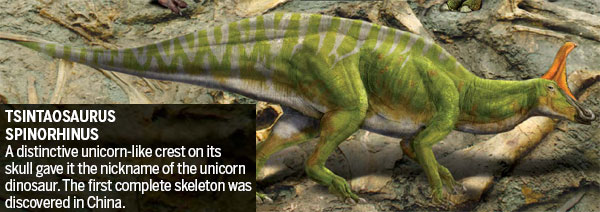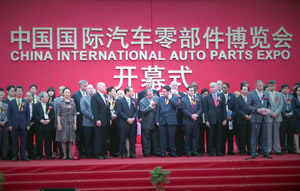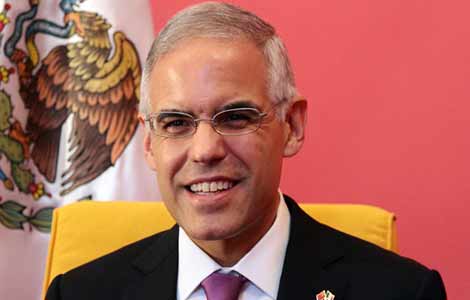Dinosaur village offers new body of evidence
Updated: 2013-09-21 08:20
By Cheng Yingqi (China Daily)
|
||||||||

Their work, Wang said, is like "extending a salute to the older generation".
In fact, Laiyang is the first dinosaur fossil site in China discovered by Chinese scientists. The earliest excavation dates back to 1923 when Chinese geologist Tan Xichou collected fossils of dinosaur, fish, insects and plants in Jiangjunding (near Jingangkou) and neighboring areas.
The first Laiyang dinosaur, Tanius sinensis, was named in honor of Tan by Carl Wiman, a Swedish paleontologist, in 1929.
In the 1950s, Yang Zhongjian, a leading vertebrate paleontologist in China, led a team to Laiyang.
They dug up fossil vertebrates and recovered China's first complete dinosaur skeleton Tsintaosaurus spinorhinus Young in 1958.
Also, fossils unearthed in Laiyang helped build up the international classification system and naming system for dinosaur eggs.
In 1984, the Society of Vertebrate Paleontology of China was established in Laiyang.
However, as more and more dinosaur and other vertebrate fossil sites were discovered in China, paleontologists swarmed to other sites, and Laiyang faded from scientists' view.
"The most significant paleontological finds in the recent decade were carried out on the fossil sites in Liaoning province," Wang said.
Wang led a scientific research team in west Liaoning for 15 years excavating large quantities of amphibian, dinosaur, pterosaur, bird and mammal fossils.
Yet Wang was always attracted by Laiyang, a site of huge potential.
"Geological records show the excavation at Jingangkou was not finished, and the fossils were in a relatively small area, and covered a host of dinosaur species," Wang said.
"When I saw the geological fault in the mountains and the valley, I knew that this type of landscape preserves fossils."
The problem was, where to start.
The exact places where Tan Xichou and Yang Zhongjian excavated had been long forgotten.
Wang's team carried out extensive geological surveys and interviewed elderly residents hoping they would still remember Tan's excavation 90 years ago.
During the search, the team found a site full of broken dinosaur bones - which they call the second site - and they started the excavation.
One of the aims of this new excavation is to find new species, Wang said.
The nasal features of Tsintaosaurus is one such question.
Previous research indicated the nose of Tsintaosaurus was directed up, different from other known lambeosaurids, a genus dinosaur that lived about 76 to 75 million years ago in the Late Cretaceous period.
But tests on Tsintaosaurus, which is currently stored in the Paleozoological Museum of China, show the nasal feature differing from the research, Wang explained. He hopes the excavation can help solve the puzzle.
Also, Wang hopes to uncover a specimen of Tanius sinensis from the Late Crustaceous period.
The only skeleton is stored in Uppsala University, Sweden.
Wang's work in Laiyang started as early as 2008.
But site conditions held back excavation as Wang tried to protect exposed fossils.
When Wang arrived at the site, the fossilized bones exposed to air had cracked and they had become fragile and powdery.
After spending a harsh winter in Laiyang with the fossils, Wang found that the fossilized bones cracked due to the change of temperature.
"So, if we can keep the fossils from freezing, they will be preserved in better shape."
In 2009, the city government of Laiyang became involved in protection of the site and its fossils and provided facilities and personnel support for the team.
So why not just move the fossils away to preserve them in a laboratory?
"It depends on your purpose," Wang said.
If researchers need to dig the fossils out for scientific study it is better to ship them to the laboratory.
But for research purposes, it is better to keep them at the original site, he said.
|
Source: Institute of Vertebrate Paleontology and Paleoanthropology at the Chinese Academy of Sciences. Guillermo Munro, Tian Chi And Feng Xiuxia / China Daily |
(China Daily 09/21/2013 page6)

 Victoria Beckham S/S 2014 presented during NYFW
Victoria Beckham S/S 2014 presented during NYFW
 'Despicable' minions upset Depp's 'Lone Ranger' at box office
'Despicable' minions upset Depp's 'Lone Ranger' at box office
 'Taken 2' grabs movie box office crown
'Taken 2' grabs movie box office crown
 Rihanna's 'Diamonds' tops UK pop chart
Rihanna's 'Diamonds' tops UK pop chart
 Fans get look at vintage Rolling Stones
Fans get look at vintage Rolling Stones
 Celebrities attend Power of Women event
Celebrities attend Power of Women event
 Ang Lee breaks 'every rule' to make unlikely new Life of Pi film
Ang Lee breaks 'every rule' to make unlikely new Life of Pi film
 Rihanna almost thrown out of nightclub
Rihanna almost thrown out of nightclub
Most Viewed
Editor's Picks

|

|

|

|

|

|
Today's Top News
Super typhoon Usagi to hit S China
US not to levy punitive duties on Chinese shrimps
Philippines evacuates coast as typhoon nears
BlackBerry warns of big loss, 4,500 job cuts
Syria details part of chemical arsenal
Action pledged for new type of Sino-US ties
Worries linger over GM rice test
Ancient site helps lift thousands out of poverty
US Weekly

|

|






